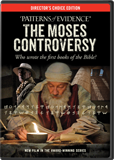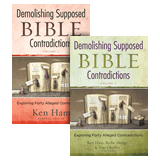
Feedback: Is the Ark of the Covenant a Biblical Copy of the Egyptian Ark of the Contract?
Some have suggested the Egyptian “ark of the contract” predates the Hebrew “Ark of the Covenant” by 1,000 years, but this doesn’t align with most accepted chronologies.
What is the position of AIG on Ark of the Covenant and its Egyptian parallel Ark of the Contract (used for a 1,000 years before Hebrew people were in Egypt). Some of the Egyptian arks look almost exactly like Hebrew Ark of the Covenant.
— J. H.
Hello, J. H., and thank you for writing to Answers in Genesis with your question.
Typically the structures are depicted in quite different fashions (boat-like for the ark of the contract versus rectangular chest-like for the Ark of the Covenant), and they served totally different purposes. Usually, the ark of the contract (often referred to as a ceremonial barque) carried the mummy of the pharaoh, or an important nobleman, a relic symbolizing an Egyptian god, and, rarely, the Egyptian Book of the Dead. In contrast, the Ark was the chosen place for the divine Shekinah (Hebrew word meaning “dwelling”) presence of the True and Living God. God also commanded that certain objects be put in the Ark (the Decalogue [Ten Commandments], Aaron’s rod, and a pot of manna). These objects did not symbolize the dead, but rather that God’s promises were still in effect or as remembrances of God’s sustaining the nation.
with a conventional Egyptian chronology and the conservative biblical archaeological dating of the Exodus, the Ark of the Covenant predates the Egyptian ark of the contract.
Based on my research, the oldest record of an “ark of the contract” dates to a court official named Userhat during the reign of Amenhotep II (sometimes called Amenophis II), who was the seventh Pharaoh of the 18th dynasty of Egypt.1 His reign is usually dated from 1427 to 1401 BC in conventional Egyptian chronology. By using the standard biblical dates for the Exodus (either 14912 or 1446/1445 BC3), Amenhotep II actually lived after the Exodus and the commandment by God to build the Ark of the Covenant (also called the Ark of the Testimony) in Exodus 25:10–22. We read that the Ark of the Covenant was built shortly thereafter (likely while the Israelites were still at Mt. Sinai) in Exodus 37:1–9 by Bezalel, on orders from Moses. Therefore, with a conventional Egyptian chronology and the conservative biblical archaeological dating of the Exodus, the Ark of the Covenant predates the Egyptian ark of the contract. The difference is even more stark when using a revised Egyptian chronology (REC), which many young-earth creation (YEC) chronologists believe is more faithful to historical and archaeological evidence. Some biblical archaeologists put Amenhotep II’s reign variously at the time of the Exodus,4 in the 1200s BC, or as late as 9405 or 872 BC6 using a REC.
So the only way in which the earliest attestation of the ark of the contract predates the Ark of the Covenant is by using a conventional Egyptian chronology and the latest date for the Exodus, which liberal scholars place at c. 1250 BC However, YEC chronologists and even some secular scholars/archaeologists reject one or both assumptions. In other words, by starting with either a revised Egyptian chronology or an earlier Exodus, it is more likely that the Egyptians copied off the Hebrew Ark of the Covenant, if the two are related at all. This is the stance that we at Answers in Genesis hold toward the Egyptian ark.
However, even if the Egyptian ark was somehow proven to be earlier (for example, discovered in a Third to Twelfth Dynasty tomb), this still would not prove the Ark of the Covenant was a copy of the Egyptian one. According to Exodus 25:9–22 and 25:40, Acts 7:44, Hebrews 8:1–5 and 9:23–25, the earthly Ark of the Covenant was based on a pattern given by God himself to Moses. So, in light of this, there are no biblical grounds to conclude that God modeled the Ark of the Covenant in imitation of an Egyptian ark dedicated to polytheistic “gods,” which were really demons—something God detested (Leviticus 17:7; Deuteronomy 32:17; Psalm 106:37; 1 Corinthians 10:20). God would have had this heavenly pattern for the Ark of the Covenant in his plans originally from the foundation of the world.
The Function and Purpose of the Two Arks
Most likely the Egyptian ark of the contract, whether or not it predated the earthly Ark of the Covenant, was a copy of Noah’s Ark (Genesis 6) and meant to symbolize “escaping death by Divine aid,” which they turned into a polytheistic legend. Like the other regional flood legends (Eridu Genesis, Atrahasis, and Gilgamesh), which distorted the Genesis flood narrative into an epic hero tale, where the protagonist escapes death through his piety and ingenuity, the Egyptian concept of the afterlife was based on whether or not one’s soul was worthy of paradise. If not, the soul was weighed against the feather of Maat (to prove or disprove its purity) and would be eaten by the demon goddess Ammut, thus ending any hope of the afterlife. Basically, like every other religion except Christianity, the Egyptians thought paradise could be attained through self-virtue and merit. The Ark of the Contract was usually carried on poles by priests (like the Ark of the Covenant) or could be pulled along by ropes. It housed the mummy of an important person (Pharaoh, priest, or noble) to their tomb and usually in a very public procession.7 The “contract” in the name of the object was one between the recently-deceased and Osiris, god of the dead and the underworld. It was basically the belief that the dead’s soul was worthy to go to the afterlife and the show of paying respect to Osiris by placing an idol of him alongside their mummy, or on top of the ark itself8 which was a contract that would ensure Osiris’ favor.
The Ark of the Covenant, by contrast had no idol or representation of God on it, which was unlike anything the Egyptians (or Canaanites) could conceive of.9 Instead it had as its covering (lid) the mercy seat with two golden cherubim facing each other (Exodus 25:17–20). And it was there that God’s Shekinah presence hovered over in cloud form (Leviticus 16:2). The Ark of the Covenant was not an object representing death, but rather was the place where the Living God chose to place his presence on earth (before Christ’s Incarnation).
It was at this mercy seat where once per year on the Day of Atonement, the high priest offered a bull and a goat, respectively, for his own sins and the sins of the people of Israel. He sprinkled incense and the blood of the bull and goat onto the mercy seat and performed the scapegoat ceremony, and then God accepted the sacrifice to cover the sins of the people (Leviticus 16:13–30). The writer of Hebrews compared this ceremony to the perfection of Christ’s sacrifice for his people (Hebrews 9:7–14). Then he concluded that as mediator of the New Covenant (Hebrews 9:15) Christ offered himself to put away our sin (Hebrews 9:26). The Ark of the Covenant therefore served as a continual reminder that without the shedding of blood there is no remission of sins (Hebrews 9:22), and it pointed to Jesus by whom “we have been sanctified through the offering of the body of Jesus Christ once for all” (Hebrews 10:10).
The Egyptian ark/barque represented death with the vain hope that a man’s sins would be overlooked if he curried enough favor with the gods. The Ark of the Covenant emphasized God’s holiness, the objects within symbolized God’s promises, and the mercy seat emphasized the seriousness of sin and the fact that an offering to atone for the sin of the people was needed every year.
The Egyptian ark/barque represented death with the vain hope that a man’s sins would be overlooked if he curried enough favor with the gods. The Ark of the Covenant emphasized God’s holiness, the objects within symbolized God’s promises, and the mercy seat emphasized the seriousness of sin and the fact that an offering to atone for the sin of the people was needed every year. But the Lord, told the prophet Jeremiah that there was a time coming when the Ark of the Covenant would be remembered no more (Jeremiah 3:15–16). The prophet Jeremiah (Jeremiah 31:31–34) and then Ezekiel (Ezekiel 36:25–27) looked forward to the time when God’s laws would be written on men’s hearts, and they would be new hearts, given along with a new spirit put within us. The writer of Hebrews took that passage in Jeremiah and showed that it was fulfilled in Christ by his once-for-all death on the cross.
For by a single offering he [Jesus] has perfected for all time those who are being sanctified. And the Holy Spirit also bears witness to us; for after saying, "This is the covenant that I will make with them after those days, declares the Lord: I will put my laws on their hearts, and write them on their minds," then he adds, "I will remember their sins and their lawless deeds no more." Where there is forgiveness of these, there is no longer any offering for sin. (Hebrews 10:14–18)
Footnotes
- Scott B. Noegel, “The Egyptian Origin of the Ark of the Covenant,” Israel’s Exodus in Transdisciplinary Perspective, Quantitative Methods in the Humanities and Social Sciences, Springer International Publishing Switzerland (2015): 229. DOI 10.1007/978-3-319-04768-3_17. https://faculty.washington.edu/snoegel/PDFs/articles/noegel-ark-2015.pdf.
- James Ussher, Annals of the World, revised and updated by Larry and Marion Pierce (Green Forest, AR: Master Books, 2003): 46.
- John Ashton and David Down, Unwrapping the Pharaohs (Green Forest, AR: Master Books, 2006): 101.
- Simon Turpin, “Evidence of Mosaic Authorship of the Torah,” Answers in Genesis, September 10, 2021, https://answersingenesis.org/bible-characters/moses/evidence-mosaic-authorship-of-torah/.
- Elizabeth Mitchell, “Doesn’t Egyptian Chronology Prove That the Bible Is Unreliable?,” Answers in Genesis, April 28, 2015, https://answersingenesis.org/archaeology/ancient-egypt/doesnt-egyptian-chronology-prove-bible-unreliable/.
- Ashton and Down, 132.
- Scott B. Noegel, “The Egyptian Origin of the Ark of the Covenant,” Israel’s Exodus in Transdisciplinary Perspective, T. E. Levy et al. (eds.) Springer International Publishing Switzerland (2015): 228–229. https://faculty.washington.edu/snoegel/PDFs/articles/noegel-ark-2015.pdf.
- Ibid.
- David A. Falk, “The Ark of the Covenant in its Egyptian Context,” Biblical Archaeology Society (May 28, 2021). https://www.biblicalarchaeology.org/daily/biblical-artifacts/artifacts-and-the-bible/the-ark-of-the-covenant-in-its-egyptian-context/.
Recommended Resources

Answers in Genesis is an apologetics ministry, dedicated to helping Christians defend their faith and proclaim the good news of Jesus Christ.
- Customer Service 800.778.3390
- © 2024 Answers in Genesis







